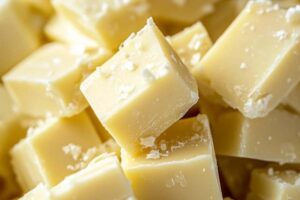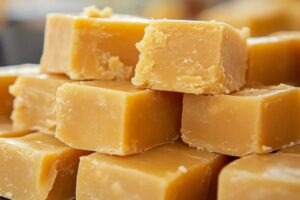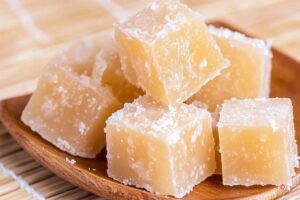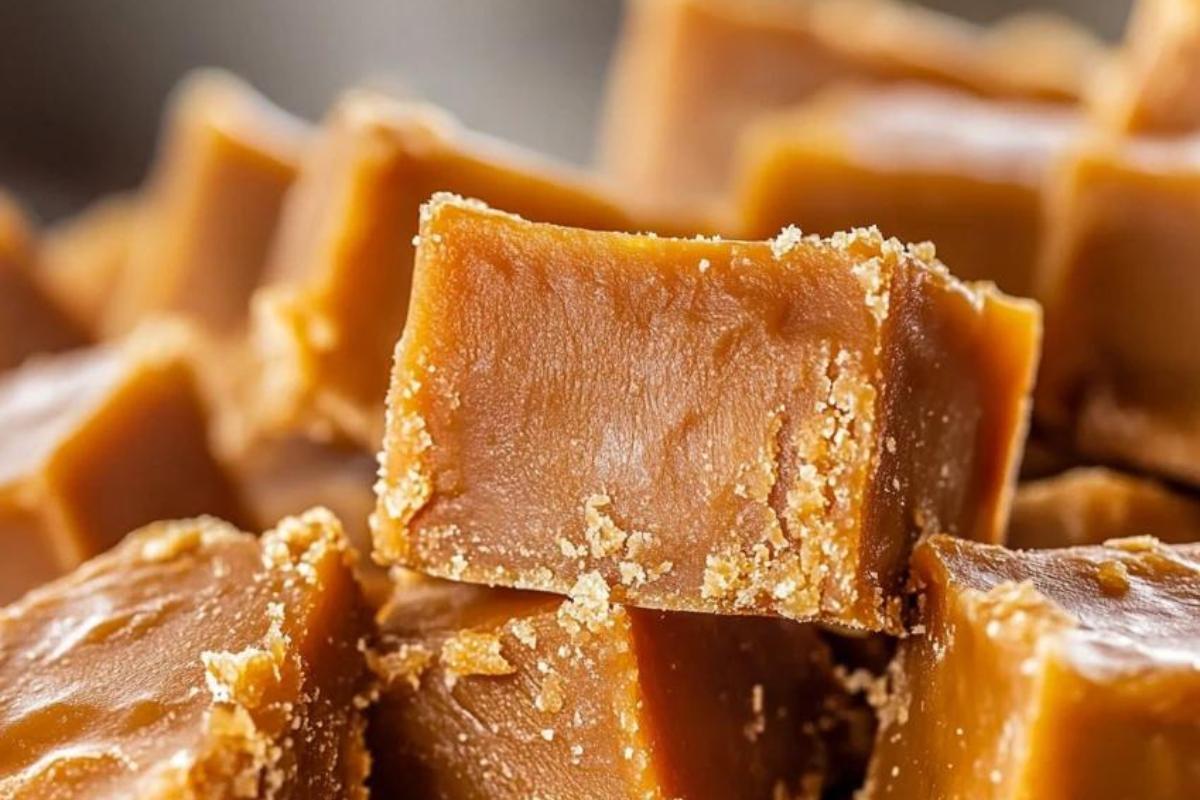Fudge is one of those delicious treats that most people can’t resist. Whether you enjoy classic chocolate fudge, peanut butter fudge, or something more exotic, achieving the perfect smooth texture is what makes fudge so irresistible. But if you’ve ever tried making fudge at home, you’ll know it can sometimes turn out grainy and less than perfect. That’s where cream of tartar comes in.
In the world of candy-making, particularly fudge, cream of tartar is a secret weapon. It plays a crucial role in helping fudge develop a smooth texture and prevents sugar crystallization. In this article, we will explore in-depth what cream of tartar does in fudge and how it works its magic to make this sweet treat silky smooth.
What is Cream of Tartar?
Before we dive into its role in fudge, let’s first understand what cream of tartar actually is. Scientifically known as potassium bitartrate, cream of tartar is a natural byproduct of winemaking. It forms inside wine barrels during the fermentation process and is refined to become the fine, white powder that we commonly use in baking and cooking.
Not only is cream of tartar an essential ingredient for candy and fudge making, but it is also commonly used to stabilize egg whites, to give baked goods extra volume, and to keep sugar syrups from crystallizing. According to the Food Network, cream of tartar plays a pivotal role in various recipes by stabilizing proteins and sugars.
In the case of fudge, its primary function is to prevent sugar crystals from forming, which results in a smooth and creamy texture. The Ochil Fudge Pantry provides further insight into how cream of tartar plays a role in making fudge silky smooth by inhibiting crystallization.
How Does Cream of Tartar Work in Fudge?
The key to understanding why cream of tartar is important in fudge-making is to grasp the science behind sugar crystallization. When you’re making fudge, sugar needs to dissolve completely in water to create a smooth mixture. As the mixture cools, it can sometimes crystallize, which leads to a grainy texture.
This crystallization happens when sucrose (table sugar) molecules start to form solid crystals as they cool down. However, cream of tartar works by breaking sucrose molecules into two simpler sugars: glucose and fructose. These smaller molecules don’t crystallize as easily as sucrose, which helps keep your fudge smooth.
Step-by-Step Breakdown of Cream of Tartar’s Role:

- Dissolution of Sugar: When making fudge, the sugar is dissolved in water and heated. Cream of tartar is added at this stage to help break down sucrose.
- Sugar Inversion: The cream of tartar facilitates the breakdown of sucrose into glucose and fructose. This is called sugar inversion.
- Prevention of Crystals: Once the mixture cools, glucose and fructose prevent large crystals from forming, leading to a smoother, creamier fudge texture.
Without cream of tartar, fudge has a higher likelihood of forming large sugar crystals, which will result in a grainy texture. The amount of cream of tartar used is typically very small—only about 1/8 to 1/4 teaspoon for a typical batch of fudge.
Why Does Cream of Tartar Prevent Crystallization?
The key benefit of cream of tartar in fudge-making is that it acts as a stabilizer. It helps control the size and structure of sugar crystals during the cooking and cooling process. When you don’t want your sugar to crystallize (like in fudge, caramels, and toffee), cream of tartar is your go-to ingredient.
Here’s a breakdown of why this happens:
- Sugar inversion: As we’ve mentioned, cream of tartar causes sucrose to break down into glucose and fructose. These simpler sugars inhibit the formation of large sugar crystals, which are responsible for giving fudge a gritty texture.
- Controlling crystallization: When sugar cools too quickly or is not properly managed, it can form large crystals. Cream of tartar controls this by preventing the formation of those crystals, ensuring a smoother consistency.
- Acidic environment: Since cream of tartar is slightly acidic, it alters the chemical environment of the sugar, making it harder for the sugar to crystallize in an undesirable way.
Benefits of Using Cream of Tartar in Fudge
Adding cream of tartar to fudge has several key benefits, especially when it comes to texture and consistency. Here’s why using this simple ingredient is crucial:
- Prevents gritty texture: The primary function of cream of tartar in fudge is to prevent the grainy texture caused by sugar crystals.
- Ensures a smooth texture: By breaking down sucrose, cream of tartar ensures that your fudge will remain soft, smooth, and creamy.
- Longer shelf life: Fudge made with cream of tartar has a longer shelf life, as it remains soft and doesn’t dry out as quickly.
- Better consistency: Whether you’re making a small batch or a large one, cream of tartar helps maintain consistency in your fudge-making process.
How Much Cream of Tartar Should You Use?
The amount of cream of tartar you should use depends on the size of your fudge batch. Typically, you only need a small amount—around 1/8 to 1/4 teaspoon. While it may seem like a negligible amount, it can have a profound impact on the final texture of your fudge.
Here’s a general guideline:
- Small batch (1 pound of fudge): 1/8 teaspoon
- Standard batch (2 pounds of fudge): 1/4 teaspoon
- Large batch (3 pounds or more): 1/2 teaspoon
Using too much cream of tartar can affect the taste of your fudge, making it too tart or sour, so it’s important to measure carefully.
Common Mistakes When Using Cream of Tartar in Fudge
Even though cream of tartar is a foolproof ingredient for making fudge, there are still a few common mistakes people make when using it:
- Using too much or too little: It’s essential to use the right amount. Too much can give your fudge a sour taste, while too little won’t prevent crystallization effectively.
- Adding it too late: Cream of tartar needs to be added early in the fudge-making process, typically when you first start dissolving the sugar in water.
- Not using it in combination with proper beating: Even with cream of tartar, you still need to beat your fudge well after cooking to achieve the correct texture. The ingredient helps, but the technique is equally important.
- Ignoring the other factors: If you neglect factors like temperature control, cooking time, or the sugar’s grain size, cream of tartar may not be able to save the fudge from crystallizing.
Substitutes for Cream of Tartar in Fudge
If you find yourself without cream of tartar, there are a few substitutes you can use in a pinch. Keep in mind that some of these substitutes may slightly alter the flavor or consistency of your fudge.
Here are some common substitutes:
- Lemon juice: This acidic ingredient can replicate the effects of cream of tartar, but it might add a slight citrusy flavor.
- White vinegar: Like lemon juice, vinegar provides acidity, but it can leave behind a noticeable flavor.
- Citric acid: Citric acid works similarly to cream of tartar but is much stronger. Use it sparingly to avoid overly tart fudge.
Pros and Cons of Substitutes:
- Lemon juice: Adds the necessary acidity but may alter the taste slightly.
- Vinegar: Effective in preventing crystallization but can impact the flavor.
- Citric acid: Strong and effective, but be careful with quantities to avoid overpowering the fudge.
Tips for Making the Perfect Fudge with Cream of Tartar

Making the perfect fudge with cream of tartar can be a rewarding experience, as it results in a smooth and creamy texture. Cream of tartar helps to prevent sugar crystallization, ensuring a fudge that is smooth instead of grainy. Here are some tips to help you make the best fudge using cream of tartar:
1. Choose the Right Ingredients
- Use High-Quality Ingredients: The quality of your ingredients—such as butter, sugar, and chocolate—makes a significant difference in the final flavor and texture.
- Cream of Tartar: This ingredient is essential for controlling sugar crystallization, resulting in a smooth fudge. Use about ¼ teaspoon of cream of tartar per cup of sugar.
2. Prepare Your Tools and Workspace
- Use a Heavy-Bottomed Pan: A heavy-bottomed saucepan will help to evenly distribute the heat and prevent burning.
- Line the Pan: Line your fudge pan with parchment paper to make it easier to lift the fudge out once it sets.
- Have Everything Ready: Fudge-making can be fast-paced, so make sure all your tools and ingredients are pre-measured and prepared.
3. Control the Temperature
- Use a Candy Thermometer: Monitoring the temperature of the sugar mixture is key to achieving the right consistency. Fudge is typically cooked to the “soft ball” stage (around 234–240°F or 112–116°C).
- Avoid Stirring at High Temperatures: Once the sugar has dissolved, avoid stirring to prevent unwanted crystallization.
4. Add Cream of Tartar at the Right Time
- Add Cream of Tartar Early: Mix in the cream of tartar at the beginning with the sugar and liquid. This helps break down sugar molecules and prevent them from forming large crystals, ensuring a smooth texture.
5. Be Careful with Stirring
- Stir Gently: Once the fudge reaches the desired temperature and is cooling, stir it gently but consistently until it begins to thicken. Over-stirring can introduce air bubbles and make the fudge grainy.
6. Cool the Fudge Properly
- Let It Cool Before Cutting: Allow the fudge to cool at room temperature for a couple of hours or until it’s firm. Don’t rush the process by refrigerating it, as this can lead to an uneven texture.
- Cut with a Sharp Knife: Once the fudge has fully set, use a sharp knife to cut clean squares.
7. Watch for Texture
- Smooth and Creamy Fudge: If your fudge turns out grainy, it’s often due to sugar crystallization. Cream of tartar helps, but ensuring that you don’t stir the mixture too soon and cooking at the correct temperature will also help prevent this issue.
FAQs: Frequently Asked Questions
Can You Make Fudge Without Cream of Tartar?
Yes, you can make fudge without cream of tartar, but you risk a higher chance of your fudge becoming gritty due to sugar crystallization. If you don’t have cream of tartar on hand, you can use an acidic substitute like lemon juice or vinegar, though these may slightly alter the flavor.
What Happens if You Add Too Much Cream of Tartar?
Adding too much cream of tartar to your fudge can result in a tart or sour flavor. Stick to the recommended amounts (usually 1/8 to 1/4 teaspoon) to avoid overpowering your fudge with acidity.
Is Cream of Tartar Essential for Smooth Fudge?

Yes, cream of tartar plays a crucial role in preventing sugar crystallization, which is the main cause of grainy fudge. By helping to break down sucrose into glucose and fructose, cream of tartar ensures that your fudge will have a smooth and creamy consistency.
In conclusion, using cream of tartar in your fudge recipe is a surefire way to achieve the perfect smooth texture. It prevents sugar from crystallizing, helps maintain consistency, and ensures that your fudge has the creamy, melt-in-your-mouth quality we all love.
For more information on cream of tartar and its role in baking and candy-making, check out the Ochil Fudge Pantry’s Ultimate Guide to Fudge or the Food Network’s Baking Guide.

